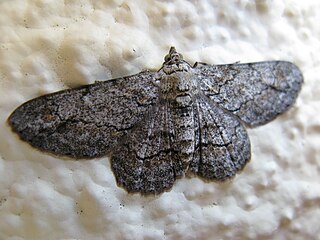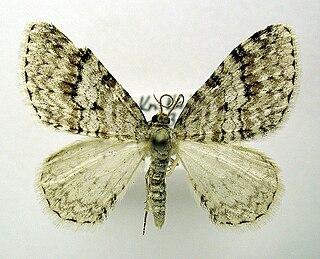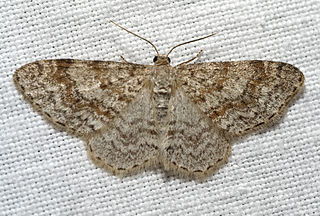
Eulycia is a genus of moths in the family Geometridae described by Anthonie Johannes Theodorus Janse in 1932.
Pachyodes is a genus of moths in the family Geometridae described by Achille Guenée in 1858.

Scopula is a genus of moths in the family Geometridae described by Franz von Paula Schrank in 1802.

Venusia is a genus of moths in the family Geometridae erected by John Curtis in 1839.

Venusia cambrica, the Welsh wave, is a moth of the family Geometridae. It is found in Europe, western and central Siberia, Altai, Transbaikalia, the Russian Far East, the Korean Peninsula, Japan and in North America, where it can be found across Canada from Newfoundland and Labrador to British Columbia, south in the west to California, south in the east to Georgia.

Asthenini is a tribe of geometer moths under subfamily Larentiinae first described by Warren in 1893. The tribe has been combined with Eupitheciini in the past, most notably by Jeremy Daniel Holloway in his work The Moths of Borneo.

Perizoma blandiata, the pretty pinion, is a species of moth of the family Geometridae. The species was first described by Michael Denis and Ignaz Schiffermüller in 1775. It is found from most of central and northern Europe to central Asia as far as the Khangai Mountains.
Louis Beethoven Prout (1864–1943) was an English entomologist and musicologist.

Pachyodes subtritus is a moth of the family Geometridae first described by Louis Beethoven Prout in 1914. It is found in China and Taiwan.
Scopula accentuata is a moth of the family Geometridae. It is found in the Democratic Republic of Congo, Kenya and South Africa.

Sterrhini is a tribe of the geometer moth family (Geometridae), with about 825 species in 19 genera. There are also 6 genera with 36 species tentatively associated with the tribe. The tribe was described by Meyrick in 1892.
Venusia albinea is a moth in the family Geometridae first described by Louis Beethoven Prout in 1938. It is found in Pakistan.
Venusia brevipectinata is a moth in the family Geometridae first described by Louis Beethoven Prout in 1938. It is found in India.
Venusia conisaria is a moth in the family Geometridae first described by George Hampson in 1903. It is found in China, Nepal and India.
Venusia eucosma is a moth in the family Geometridae first described by Louis Beethoven Prout in 1914. It is found in China.
Venusia inefficax is a moth in the family Geometridae first described by Louis Beethoven Prout in 1938. It is found in China.
Venusia laria is a moth in the family Geometridae first described by Charles Oberthür in 1893. It is found in China and Japan.
Venusia lilacina is a moth in the family Geometridae first described by William Warren in 1893. It is found in China, Nepal and India.
Venusia nigrifurca is a moth in the family Geometridae first described by Louis Beethoven Prout in 1926. It is found in China and Myanmar.
Venusia punctiuncula is a moth in the family Geometridae first described by Louis Beethoven Prout in 1938. It is found in China.






